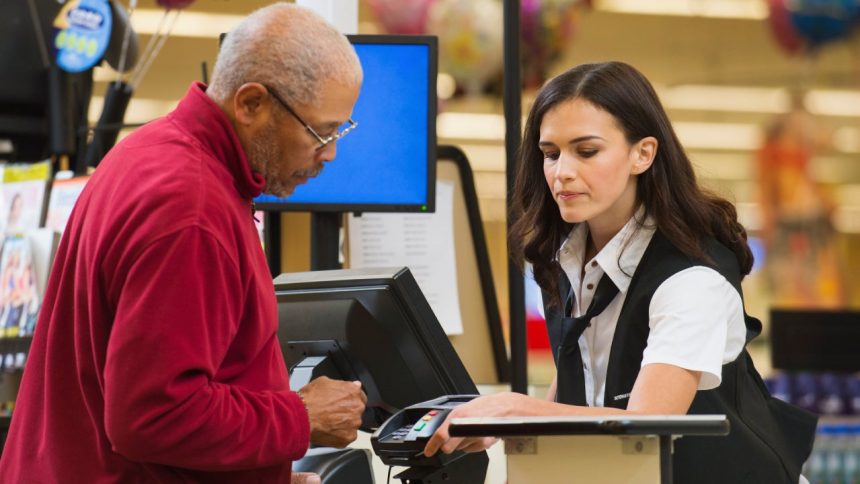Erik Isakson/Getty Images
Key takeaways
- You can purchase a money order at a bank, credit union, at USPS locations and some stores.
- Money orders are generally for purchases of $1,000 or less.
- Money orders offer guaranteed payment and can’t bounce.
Money orders can be a convenient way to pay for something with secure, guaranteed funds. They’re popular as a way to pay bills or to send money to friends and family.
You can get a money order from many places, including banks, credit unions, retail locations, grocery stores and the post office. Here’s what you should keep in mind about each place:
Your bank or credit union
If you have an account at a local bank or credit union, the best place for you to get a money order is likely with your financial institution. Getting your money order from the bank means that your bank can deduct the funds directly from your account. You don’t have to carry large sums of cash to another location to purchase the money order.
Some institutions will charge a small fee to sell you a money order.
Retail stores
Retail stores are also a popular place to purchase money orders. There are stores dedicated to offering financial services, such as check cashing and money orders, that you can visit. For example, Western Union is a well-known company that offers money orders and other financial services.
Many grocery stores, such as Kroger, allow customers to buy money orders.
Big box stores like Walmart may also sell money orders. You can also buy a money order at convenience stores such as 7-Eleven, which accepts cash or debit card payments for money orders.
Post office
The United States Postal Service has a long history of offering financial services to Americans.
Today, USPS money orders are popular for their low cost. You can buy or cash money orders at any USPS location. The fee for your money order is based on the dollar amount.
How much does it cost to buy a money order?
The price of a money order varies based on where you’re buying the money order and the amount of the money order. Generally, larger money orders will cost more.
For example, the USPS charges:
- $2.55 for money orders ranging from $0.01 to $500
- $3.60 for money orders between $500.01 and $1,000
At Walmart, you will pay no more than $1 for your money order. At Wells Fargo, you will pay $5 to purchase a money order in any amount up to $1,000.
Why use a money order?
There are several reasons why using a money order can be a good idea.
- Money orders are guaranteed. This means that, unlike a check, you know an authentic money order won’t bounce — like a personal check could.
- Keeps your financial information private. Money orders are also a good way to keep your financial information private. If you want to send money to a friend or family member, you can use a money order so you don’t have to provide banking details such as account numbers or routing numbers.
- No bank account is required. Even if you don’t have a bank account, you can still use a money order to send money to someone.
Alternatives to money orders
Various payment options can be used as alternatives to money orders.
Peer-to-peer payments: Sending money electronically is a convenient way to transfer money from your checking or savings account directly to that of a friend or relative. This is often free, although some providers charge a fee for faster transfer times. Some popular peer-to-peer services include:
- Zelle
- Venmo
- PayPal
- Cash App
Personal checks: Writing a check is a simple way to make a payment from your checking account. Unlike the typical money order, you won’t be limited on how much the check is for, as long as you have the money in your checking account to cover it.
Cashier’s check: Issued on your behalf by your bank or credit union, a cashier’s check is a way you can make a payment that’s backed by the bank’s funds. Banks typically charge $5 to $15 to issue a cashier’s check.
Sending money orders
Here’s what you should know about sending a money order. The following is a rundown of things you should know about sending a money order, payment methods and what to do with your receipt.
How to send a domestic money order
Visit a post office, financial institution or another authorized provider. Once you get the money order, write the recipient’s full name and other necessary details. If necessary, you can also include a memo or account number for the payment. Pay the money order amount plus any required fees, which depends on the issuer. Finally, send the money order to the recipient (make sure all details are filled out).
What are the payment methods accepted for money orders and the post office?
Make sure to bring cash or a debit card because credit cards are typically not an accepted form of payment at the post office.
What should you do with your money order receipt?
It’s a good idea to keep your money order receipt for tracking and proof of purchase. This could help you recover your funds if the money order is ever lost, stolen or damaged.
Why we ask for feedback
Your feedback helps us improve our content and services. It takes less than a minute to
complete.
Your responses are anonymous and will only be used for improving our website.
Help us improve our content
Read the full article here














